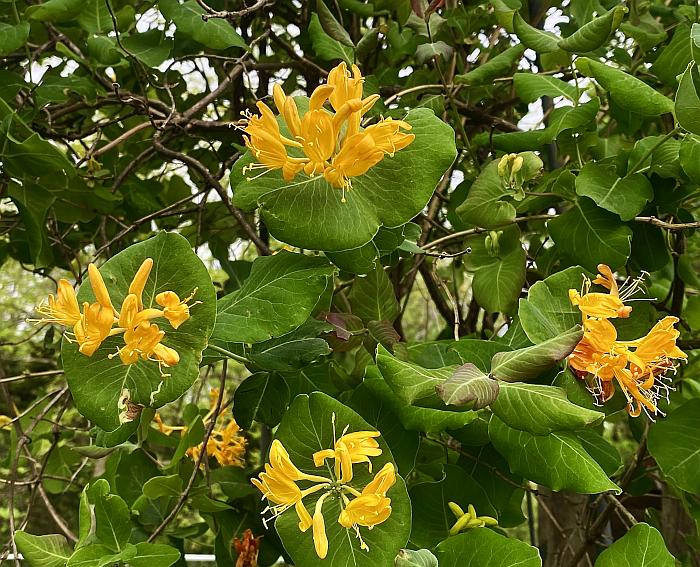Lonicera flava Sims
Yellow Honeysuckle

Native
CC = 7
CW = 5
MOC = 41
© JTrager
Lonicera flava SimsYellow Honeysuckle | |
 |
Native CC = 7 CW = 5 MOC = 41 |
© JTrager |
|
Family - Caprifoliaceae Habit - Lianas to 4 m or more long, the main stems loosely twining toward the tips, climbing on adjacent vegetation, or occasionally more or less trailing on the ground. Stem - Twigs glabrous, usually glaucous, the pith hollow, the bark of older branches sometimes becoming shredded. Winter buds conical but somewhat flattened, glabrous.
Leaves - Simple, opposite, sessile to perfoliate. Blades mostly 3-9 cm long, 2.0-6.5 cm wide, most elliptic, rounded or more commonly angled at the base, rounded or more commonly angled or tapered to a bluntly or sharply pointed tip, those of the uppermost 1 or few pairs strongly perfoliate, 1.2-2.2 times as long as wide, the pair broadly elliptic to oblong-elliptic in overall outline, rounded or broadly angled to bluntly pointed tips, sometimes abruptly tapered to minute, sharp points, the upper surface glabrous and bright green (that of the perfoliate leaves sometimes slightly glaucous toward the center), the undersurface glabrous or sparsely to moderately pubescent with soft, more or less spreading hairs along the midvein, slightly to moderately glaucous (usually pale green).
Inflorescence - Flowers in 1 or 2 whorls of 6 at the branch tips, the flowers sessile, the 2 bracts each 0.8-3.0 mm long, free, oblanceolate to bluntly triangular, glabrous, the pair of bractlets on opposite sides of each flower minute (0.4-1.2 mm long), free, oblong to broadly ovate.
Flowers - Calyces glabrous, the lobes 0.2-0.4 mm long, broadly oblong-rounded to broadly triangular, often pale or whitened. Corollas 20-35 mm long, strongly zygomorphic, divided 1/3-1/2 of the way to the base into 2 recurved-curled lips of about equal length, the upper lip shallowly (3)4-lobed, the lower lip with 1 lobe, the tube slender and not swollen or pouched near the base, bright yellow to orange, sometimes strongly reddish-tinged along the tube, not changing color after pollination. Stamens and style exserted from the corolla, slightly longer than the corolla lobes, the style usually glabrous. Ovaries free.
Fruits - Berries 5-10 mm in diameter, orangish red to red. Flowering - April - June. Habitat - Mesic to dry upland forests, edges of glades, savannas, ledges and tops of bluffs, streambanks, roadsides. Origin - Native to the U.S. Lookalikes - Other native species of Lonicera. Other info. - This attractive species occurs mainly in a cluster ranging from east-central Missouri southwest through south-central Oklahoma. Smaller disjunct populations are found farther east. The plant is recognized by its vining habit and the distinctive pair of strongly perfoliate leaves which subtend each inflorescence. This species is further recognized by its flowers of bright yellow (when fresh), later fading to reddish. It is available from some native plant nurseries and is highly deserving of more frequent cultivation along arbors and fence rows. Photographs taken in Bel-Nor, St. Louis, MO, 5-2-2023 (SRTurner); also in Gray Summit, Franklin County, MO, 5-5-2023 (JTrager). |